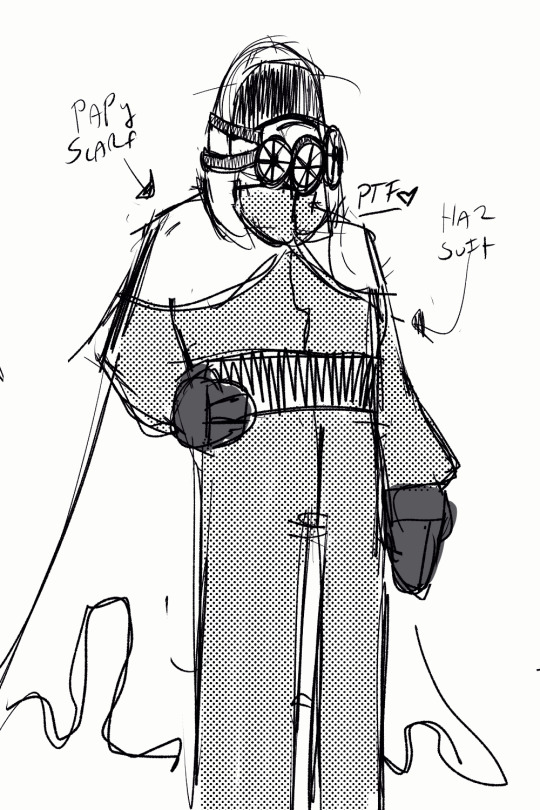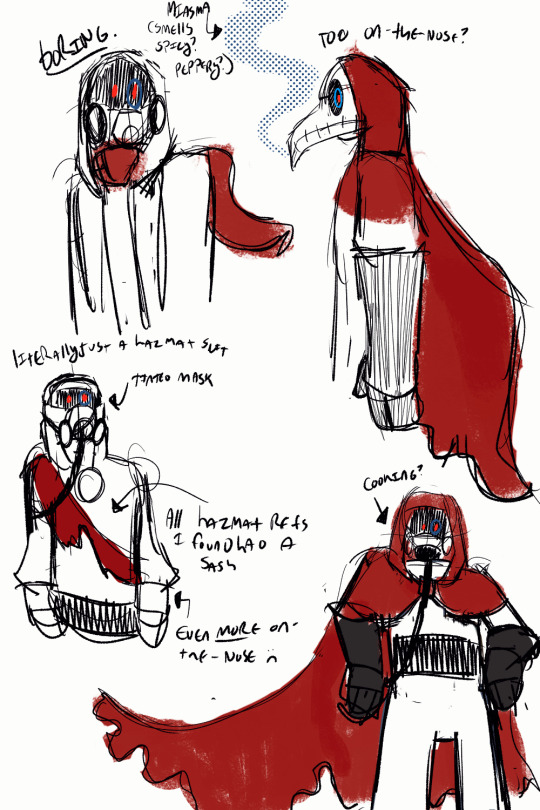#Effective Training Design
Explore tagged Tumblr posts
Text

Actually, the bars aren't so bad anymore.
Think you can fix him? Read about his care instructions over at Tiger Tiger)
#Tiger Tiger#ludovica bonnaire#rakkatak ann#I thought I liked him (in a way he has a great design and is an effective antagonist) and *then* he licked the spit.#Now I need to create a lab to study him in. My god. He gives me hives. I need to see more of him NOW.#Something is wrong with him and it fascinates me.#He is everything I like in an antagonist. A little bit stupid and unintentionally funny while being a genuine threat.#I call him rat man they way I want to see him skitter around on the floor.#Call him rat man the way he might need a little cheerio snack and some enrichment.#I am so...so tired and I am struggling to keep the jokes train going.#Please continue to read Tiger Tiger! Every new reader fuels my energy gauge.#Sorry I've been missing so many days of posting. I'll try to make up with some extra posts this week!
2K notes
·
View notes
Text


EcoGenesis is a reasearch insitution that dedicates itself to learning the origins of the world and work to restore it. Over the years they have lost funding and support.
#Oc#original character#oc art#art#my stuff#flint whistlebrook#penelope pyre pyrite#Quirk whistlebrook#Oliver Ferros#stvh#surprise sudden oc drop#It's a bit iconsistently messy because i kept editing their designs over months#deciding to make their aircraft a train changed the whole comic lmao it had a way bigger butterfly effect than i expected#in a good way#idk if i'll reblog this to tatck or not hrm#i probably will once i finish the first comic part
361 notes
·
View notes
Text

Last comicfrin au party member finally designed BABEY!!! I can finally walk into the ocean forever
#keese draws#isat#I was worried abt designing her but I actually like how she turned out :]#she’s very silly her favorite hobby is vastly overestimating the average person’s craft knowledge#well her real favorite hobby is training different work animals but yknow#in terms of hypothetical gameplay she’s mostly about doing consistent damage and applying overtime damage and slowing effects on enemies#she’s the reliable dps and support while the leader is the unreliable dps and support lol#new game+
10 notes
·
View notes
Text
It’s just. How did they mess up ROTT that badly??
Like. The plot of the movie was basically already covered in Unbecoming. We’ve already seen it play out
How is an almost two hour movie worse than a 23-minute long episode??
#Owl Hoots#I have a lot more thoughts on it#there were so many bad thing#*things#like. that was not good characterization#Jim. Jim why are you saying you were always curious about your dad#no!!! no!!!!! you yourself said you don’t care about him!!!!#ROTT#Rise of the Titans#and like. the ending???#did they just entirely forget Unbecoming??#Merlin’s Amulet would have chosen Jim#Jim going back in time wouldn’t have made Toby the Trollhunter#that… that makes no sense#Merlin said it himself#he didn’t make a mistake choosing Jim#he wouldn’t have chosen Toby#I have to say tho there were a good handful of things I did love or like#The animation and special effects#Douxie and Nari switching bodies? Clever#the use of trains and the turntable thing#I absolutely adore trains#Nari and Skrael fighting. That was cool#I think the design of the MagicTech armor was AWESOME#only complaint is I wish Excalibur had changed to match the armor#but that’s whatever#before I watched it I heard that Toby’s death didn’t make people cry because there were too many unnecessary deaths#so it made it not hurt#well I definitely cried#Jim’s reaction to Toby’s death hurt so much
14 notes
·
View notes
Text
I may or may not be compiling a chronological list of nearly every locomotive ever directly because of starlight express
#I’ve got down 103 locos so far#this was born out of frustration of not being able to find a chronological list of electric trains#bc visually Electra looks most like the SNCF CC40100#like their helmet n shit#which makes sense because they’re quad voltage and not ac or dc (like in the song) and also incooperated several different#innovations in electric locomotives#but it also doesn’t make any sense. bc the cc 40100 was like from the 60s and Electra is the engine of the future and everything#so I wanted to look at what electic locos were made in the 80s for autism purposes#anyways. I did land on one- there are two prototypes made in the 80s based on the cc 40100#which is the SNCF BB 20011 and the SNCF BB 20012#which have the same visual design as the cc 40100 and when you look up pictures of em have lightning bolts on the side#and they’re prototypes which I like to imagine Electra is#and they’re only dual voltage not quad voltage but Electra’s like ac dc it’s okay by me so it still fits#admittedly they weren’t really prototyping anything exciting and I would’ve preferred an american engine as opposed to a french one but#beggars can’t be choosers.#if you can’t tell by now this entire post was an excuse to infodump about trains#so I am going to tag the stex fandom. to make my train autism everyone else’s problem#idk if the tag will even register I once read that only the first seven tags actually make any effect on the tagging system but who caressss#stex#the story of the locomotive who raced against a horse and lost and the locomotive that was powered by a horse shall wait till another day.
5 notes
·
View notes
Note
38 and 39 for the ask game!
(Love your art by the way)
38: fav song at the moment?

pawprint panic | party at club bug | love birds
39: youtuber you've been obsessed with and why?

link to scruffy's youtube channel
#i dont really have a set music taste cuz i just listen to whatever i like but i think i lean towards bedroom pop???#these songs come to mind bc theyre relatively new so i havent gotten tired of listening to them yet lol#i do love snailshouse's love songs and ordinary songs 5 albums.. as well as cavetown and sidney gish#but i dont have any real way of discovering music outside of oc amvs and listening to the rest of an artists discography#i also dont watch a lot of youtubers to begin with but i really like scruffy and solo solo travel.. hes a japanese travel vlogger that#my mom likes and he usually rides trains and documents the whole trip. doesnt speak but writes his thoughts in subtitles#hes pretty funny and his videos are relaxing to watch so i can see why my mom likes him lol#i highly recommend scruffys fnaf sound effects videos.. its interesting to see how sound design is incorporated as a part of#game atmosphere without even realizing it!! and his video for totks instruments is interesting too!!!#ask#ask game#answered#yapping#doodles
45 notes
·
View notes
Text

rough germaphobic dust sketch inspired by this post. idk if i cooked here but i did have fun. concept art/ideas under the cut


#skeledoodles#dust sans#utmv#i kinda liked plague doctor dust....#but i think its just cause i like plague doctors in general#plague doctors believed in that smells caused disease#and called it 'miasma'#and in order to counteract it theyd have their own miasma which usually smelled floral#i do NOT think dust would subscribe to miasma theory#because sans is a man of science#but i DO think that#in a world where he did#his miasma would be like. peppery and spicy. idk how to explain it#spicy as in a lot of spices. not like its hot#anyway what im trying to say is that it wouldnt be floral#i kinda liked the full hazmat design ngl#but it felt too on the nose#then again the chosen design is also very on the nose#ignore the other drawing. the third one#that was my initial sketch lmao#i kinda had a rough idea of the design already in my head but#wanted to explore other concepts#and im glad i did because#the final drawing looks way better#OH ALSO#the reason the miasma smoke is blue#is because if mafiatale can have its magical blue cigar smoke#i can have my magical miasma smoke#i think magic can take any form given training and focus. including gas#what effect would the miasma actually have?........ idk lmao its 3am ill think on it tomorrow
7 notes
·
View notes
Text

Back again, this time with a new IL OC!
Been tossing around here and there the "what if" of a sequel of sorts, so naturally that means some new faces running around. Masami is one of those faces.
I'll probably talk about her more some other day (once I iron things out a bit more), but important thing to know is she's mute (primarily communicates through painting cryptic hints, just like her mentor), is pretty dang young by Leaguer standards, and Juurota took her under his wing.
He swears he didn't adopt her and he's not a dad, just is teaching her the way of the blade. And providing shelter and fuel and enrichment and also taught her how to communicate in a way that worked for her and gave her a name.
#IL OC#I think that's what I'll tag that for now#Btw if some of the stuff looks weird about these 'next gen' leaguers I'm taking design cues from tech from the 00's#Since IL is like. The Future but a very early 90's future so it makes sense a sequel would still fall under that retro futurism flair#In particular her mask takes cue from those robo-chi toys. It's pretty strong despite how decorative it looks#The ears on the mask also acts as a second set of audials to pick up more sounds if needed#Her armor also takes notes from hifus which are padded vests commonly worn by kids at sichi go san#To really drive home the point she's REALLY young.#Some twisted fuck really built a toddler to train her more effectively at killing once she's fully upgraded for the Kendo Leauge#Even in a sequel after a happily ever after there's still some pretty effed stuff#But it's all good she has a mentor in dad-nial
5 notes
·
View notes
Text
one of my more plausible but out there conspiracy theories is that I’m convinced the post-2018 Electta costume was designed with Mykal in mind. God knows why, it’s ironic with how it’s been near nonstop twink Electra and it was years after there was no way he was coming back. But the pieces fit. The design just looks so much better with darker skin (especially with the silver-heavy makeup) and it seems to have been intentionally changed to look better on shorter/thicker builds with the flatter torso area.
#i’m very blah on the design but seeing it on lashane made me go hmmm because he seemed made for it#“this feels intentional but why if they routinely cast the opposite of that?”#i think electra is far more interesting and effective the boxes you check on minority bingo buuut my views are very us/uk based#germany has different train politics so i’m less harsh on demonizing electrification there
3 notes
·
View notes
Text
I like the rebranding I think the old logo needed updating and the new one is more dynamic. And I like that the GP kinda looks like a circuit

#motogp#I’m not calling it MGP#that’s a very obvious let’s follow f1 path#but I think that they need a way to condense motogp for smaller sized icons like for socials and stuff#so I get why they’ve done that#I don’t think it’s boring and the way they’ve animated the text is very cool and I can see it looking for smooth for the broadcast#I also think it’s LEAGUES above the f1 logo which is borderline ineligible#why do people always hate on shit blindly I think it’s so unfair and opposing of change#maybe this is too nice of me but do yall not get that there’s swarms of people and designers and creative minds that go into rebranding#it’s not entirely just corporate buisness money grabs#I hate the hate trains on anything new because there’s so many dedicated people behind the scenes who put a lot of work into that#and the companies they’re hired by are now gonna see them getting raked through the mud#when the criticism is barely that deep and it’s just internet people being loud for the sake of it#except the knock on effect is that those artists get discredited for their honest work#it’s just unfair when 80% of people are barely even series#they’re just jumping on the bandwagon#whatever I’m going to sleep
5 notes
·
View notes
Text
24 hours ago I liked a ship in a real “I just think their neat” vibe but then I had Revelations about it and it’s suddenly turned into a brain rot mix of “oh my god why did you half ass this so badly in canon” and “oh my god there’s so little in canon I can twist it however I want in fanfics” because both characters got the bare minimum character development after the halfway point in the manga with minimal backstories.
So that’s fun.
That’s really what I needed more and different brain rots to the ones I already had.
#fanfiction#fanfic#fanfic writer#not sure if I’m gonna tag the ship or the fandom#to hell with it#it’s My Hero Academia#Itsuka/Momo#their vibe was on point#then I realised their designs are like inverses of each other#Momo’s got the smooth dark coloured spiky ponytail and Itsuka has the bright rough one#Momo has the super complicated quirk she had to study to use effectively#and Itsuka has the brutally simple quirk that she’s trained everything to use effectively#Itsuka loves coffee and Momo loves tea#Itsuka is purely hand to hand and Momo keeps getting net guns and stuff#this is the true rivals to lovers ship Horikoshi should’ve done#Momo has rich girl vibes and Kendo has brutally middle of middle class vibes#this is why vibe shipping is great#eventually you get the revelatory breakdown#also has the bi4bi vibes#they’re gonna need their own fic eventually and not just be part of one of the two polycules in wings#Jackattack rambles
2 notes
·
View notes
Text
I really wish mieruko chan could help itself from being relentlessly, uncomfortably horny
#rambling train car#I feel like there’s a coupling of most horror with excessive and exploitative horniness that works to detract from its effectiveness#when I’m engaged with the fear of a scene#and I suddenly see something that’s blatantly designed to titillate#it rips me right from my immersion and I’m like ‘oh… ok’#not to say that nudity and sexuality can’t accentuate horror. that’s a blatant lie lmao#like. aono kun does it really well . it’s one of the scariest things I’ve ever read
3 notes
·
View notes
Text
Professional Web Designing Course in Madurai – Build a Thriving Career in Web Development!
Are you looking to start a dynamic career in web design? Our Professional Web Designing Course in Madurai is crafted to guide you through every aspect of building stunning, responsive websites from scratch. Whether you're a beginner or someone with basic knowledge, this comprehensive course will teach you the essential skills and techniques required to succeed in today’s digital landscape.
Website : https://tandeminformatics.com/
#Software Courses: Software Courses#Animation Courses#IT Training#Data science and Data Analytics#Full stack development#Software Testing#C#C++#Java#Dotnet#Python#Networking and Cloud#Web development. Animation Courses: Graphic Designing#UI UX Design#2D & 3D Animation#Game Designing#Visual Effects#Digital Marketing.
0 notes
Text

Unlock your creative potential with the best sound design programs in Montreal. Learn cutting-edge techniques in audio editing, sound effects, mixing, and post-production for music, films, and games. These hands-on programs are taught by industry professionals in Montreal's vibrant creative hub. Whether you're a beginner or looking to specialize in sound design, these courses will prepare you for a successful career in the audio industry. Enroll today and bring your sound ideas to life!
#Sound Design Programs Montreal#Best Sound Design Courses in Montreal#Learn Sound Design Montreal#Audio Design Training in Montreal#Montreal Sound Design Schools#Sound Design for Films and Games Montreal#Professional Sound Design Classes Montreal#Top Audio Design Programs Montreal#Post-Production Sound Design Montreal#Sound Effects Design Courses Montreal
0 notes
Text
Relax, Rejuvenate, and Restore at Heyue Massage in East Geelong
Are you feeling stressed, tired, or burdened by muscle aches? It’s time to experience the healing touch of Heyue Massage in East Geelong. We specialize in delivering the ultimate relaxation and relief through our professional massage therapy services tailored to your individual needs.
Why Choose Heyue Massage? At Heyue Massage, we are committed to enhancing your well-being by offering a wide range of therapeutic treatments designed to relax your body, rejuvenate your mind, and restore your energy. Here's what makes us stand out:
1.Expert Therapists Our skilled massage therapists are trained to provide a variety of techniques, ensuring every session is a personalized experience.
Comprehensive Services Whether you need a deep tissue massage to relieve muscle tension, a remedial massage for pain management, or a relaxation massage to unwind, we’ve got you covered.
Convenient Location Located in the heart of East Geelong, Heyue Massage is your go-to destination for quick and effective wellness solutions.
Our Signature Treatments
Relaxation Massage: Drift away in a state of bliss as our therapists ease away your stress.
Deep Tissue Massage: Perfect for tackling persistent aches and sore muscles.
Remedial Massage: A therapeutic approach to address specific health concerns and promote recovery.
Benefits of Regular Massage Therapy Massage isn’t just a luxury; it’s an essential part of self-care. Regular sessions can:
Relieve stress and anxiety
Improve blood circulation
Boost your immune system
Enhance flexibility and mobility
Promote better sleep
Book Your Experience Today Heyue Massage in East Geelong is dedicated to providing a sanctuary where you can relax, rejuvenate, and restore balance to your life. Whether you're treating yourself or looking to address a specific issue, we’re here to help.
Address - Shop 8/136 Ormond Rd, East Geelong VIC 3219 Contact us - 488 998 090
Heyue Massage,#Massage Therapy,#Relaxation Massage, #Remedial Massage,#Deep Tissue Massage,#Soothing Massages,#East Geelong Massage,#Muscle Relief Massage,#Professional Massage Services,#Massage Near Me,#Body Wellness,#Stress Relief,#Pain Management,#Rejuvenation Massage,#Full Body Massage, #Traditional Massage Techniques
#Are you feeling stressed#tired#Why Choose Heyue Massage?#At Heyue Massage#we are committed to enhancing your well-being by offering a wide range of therapeutic treatments designed to relax your body#rejuvenate your mind#and restore your energy. Here's what makes us stand out:#1.Expert Therapists#Our skilled massage therapists are trained to provide a variety of techniques#ensuring every session is a personalized experience.#2. Comprehensive Services#Whether you need a deep tissue massage to relieve muscle tension#a remedial massage for pain management#or a relaxation massage to unwind#we’ve got you covered.#3. Convenient Location#Located in the heart of East Geelong#Heyue Massage is your go-to destination for quick and effective wellness solutions.#Our Signature Treatments#- Relaxation Massage: Drift away in a state of bliss as our therapists ease away your stress.#- Deep Tissue Massage: Perfect for tackling persistent aches and sore muscles.#- Remedial Massage: A therapeutic approach to address specific health concerns and promote recovery.#Benefits of Regular Massage Therapy#Massage isn’t just a luxury; it’s an essential part of self-care. Regular sessions can:#- Relieve stress and anxiety#- Improve blood circulation#- Boost your immune system#- Enhance flexibility and mobility#- Promote better sleep#Book Your Experience Today
0 notes
Text
Are you Interesting in Designing??
Choosing the Right Tool for Your Needs:
The choice of tools taught in these institutes reflects the current demands of the graphic design industry. Here’s a brief overview of why these tools are essential:
Adobe Photoshop & Illustrator: These are industry standards, indispensable for most graphic design tasks.
Adobe InDesign: Crucial for any designer working with print media or layout-heavy projects.
Sketch & Figma: Perfect for UI/UX designers, offering features that cater specifically to web and app design.
CorelDRAW & Canva: Great for beginners or those looking for alternative tools to Adobe’s suite.
3D Tools (Cinema 4D, Autodesk 3ds Max): Important for designers looking to expand into 3D modeling and animation.
Join DB Design Tech Today!
Start on a creative journey with DB Design Tech and turn your passion into a profession. Our focus on quality education, practical skills, and career development ensures that you’re not just learning – you’re preparing for a successful future in graphic design and video editing.

Visit our campus or contact us today to learn more about our courses and how we can help you achieve your dreams. At DB Design Tech, creativity meets excellence.
Call or WhatsApp☎️ 089500 07600
Visit in office 🏢 (ADDRESS)- SCO 45 , Ekta Complex Pipli Road Near Vishal Mega Mart, opposite New Bust Stand, Kurukshetra, Haryana 136118
#kurukshetra#animation#top graphic training institutes in karnal#best graphic design courses in haryana#artists on tumblr#top graphic training institutes in haryana#digital illustration#video editing#motion graphics#after effects#glitch art
1 note
·
View note